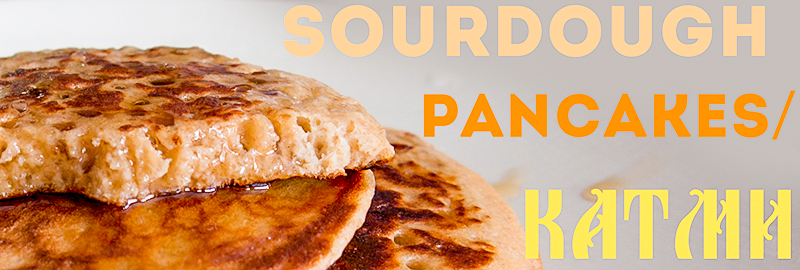The world is full of pancakes and waffles–it seems like every cluster of people comes up with their own vision for what is called a pancake. On the other side of the spectrum are the others having cravings for waffles and their wells filled with maple syrup (just for an example!).
Sourdough pancakes! Countless times I tried to make them perfect. Nope! I can barely make them edible. Until the other day. I would like to share my adventures with the sourdough culture. The side effect is the sourdough pancakes.
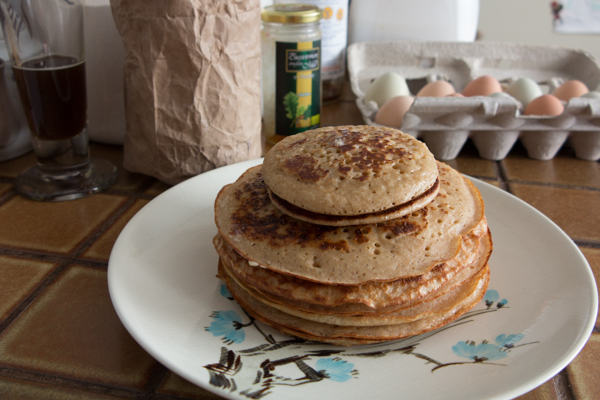
Simple ingredients–delightful cakes.
Like a lot of people on Earth, I have a special relationship with pancakes. My grandmother taught me how to make crepes. Her recipe follows: to every egg, add one cup of flour and one cup of water, pinch of salt and a teaspoon of sugar. This is the basic recipe. But here’s the deal: my grandma has all kinds of different cup measurements. Starting from the smallest “cup”, the shot “cup”, the wine “cup”, water “cup”, goes through the tea “cup” and who knows where it ends. Translated to modern English the recipe sounds like this: two eggs to one cup (250 ml) flour and one cup water, a pinch of salt and a teaspoon of sugar.
The crepe recipe is awesome because it doesn’t use any leavening agent–no baking powder, nor soda, nor yeast. But lets say we settled. We grew roots. Someone from the settlement gifts us a sourdough culture as a gesture of love or thankfulness. We got a slurry in a jar or may be a dry starter-cookie. What to do next?
If it is a cookie, we can keep it for quite a while in the fridge (dry and cool, out of sunlight place, please), but what if it is a slurry? OMG, it is ALIVE! You can name it or not, but it is alive and it has character. The best I can describe it is simply “culture”. But what is it exactly? It is a colony of single celled microorganisms, namely wild yeast, yogurt bacteria and vinegar bacteria. And yeast is a single celled relative to mushrooms. These guys are evolutionary old and primitive. Their lifespan cycles within hours. We might say they live on a fast pace, constantly adapting to the changes in the surrounding media. Many generations will pass only for few months of baking.
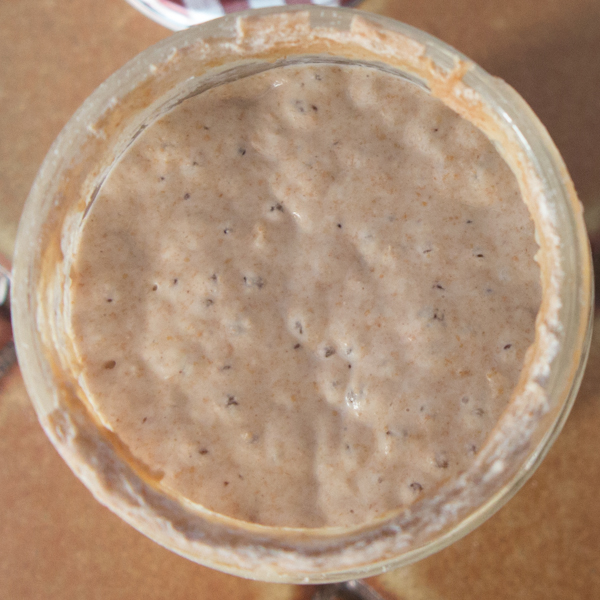
OMG, it’s ALIVE! Bursting with gas, I call it “frog eyes”.
But first things first… You need to feed your culture. Luckily, it’s easy as it eats flour, breaths air and drinks… yep!, water.
Don’t scoop and toss the culture as you might be advised elsewhere. Instead, become friends. This might turn to be your best friend, sharing the warmth and feeding you with fresh loaf of bread everyday. You just need flour and salt. To your small amount of sourdough starter you just have received, add twice as much both water and flour. After 24 hours at room temperature, add again close to twice as much both water and flour. In another 24 hours (or less) the culture will swell to a hefty 1/2 lb culture by weight, ~3 cups by volume in its peak.
It grows fast. Watch it. But if you are not planning on any baking, feed the starter and leave it in the fridge (cool room, above freezing). Like that it will stay fresh and active for few days.
The real thing is coming. The pancake (not crepe) is a cake baked in pan. To get the cakey texture we need bubbles in the batter and I have a good friend who can make a lot of bubbles–just watch it!
The Recipe
Ingredients for around 8 5-inch pancakes (all room temperature):
2 eggs
1 cup (250 ml) or so active sourdough starter culture
1 cup flour (your favorite one)
1 cup milk (or yogurt, buttermilk, kefir)
1 pinch sea salt
1 tsp or so honey
1/2 tsp vanilla extract
butter for oiling the pan and spreading onto the hot cakes.
Everything is better with butter.
Time for preparation the batter and baking the cakes–around two hours.
Time for preparation the culture–48 hours.
The good things happen slowly.
The living culture follows a pattern of rise and fall every time it is being fed. Within 12-24 hours, depending on its temperature, the slurry will double its size, bursting with gas. This is the peak of activity. Now is the time to feed it again.
For example: Day 1. Start with 1/2 oz. of mature culture, then feed it with 1 oz. water and 1 oz. flour. Mix well. Let it sit and rise for 24 hours. Now we have 2 1/2 oz. of mature culture. Day 2. Then feed it with 3 oz. water and 3 oz. flour, mix well, let it sit and rise overnight–we got a cup of mature culture ready to bake. Easy as that.
On the actual baking day (Day 3):
-In a bigger bowl, crack and whisk two eggs until fluffy.
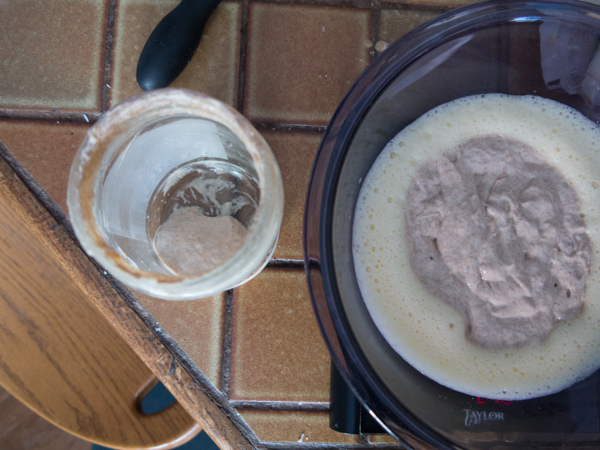
Don’t forget to leave a tablespoon of mature culture behind. Buy farm fresh eggs and whisk them well.
-Combine 1 cup of active culture (don’t forget to leave a tablespoon or so of mature culture, feed it and set aside in the cool room) and mix well with the eggs, using the whisk.
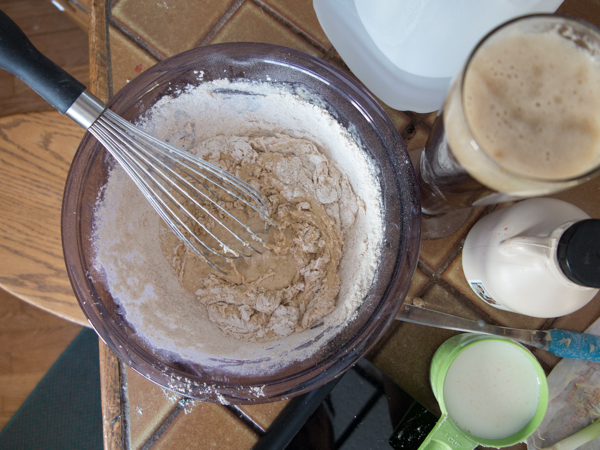
-Start adding flour and whisking. The idea is to keep it thick so clumps will not form. If it gets so thick that it is difficult to whisk, add some milk but not all of it.
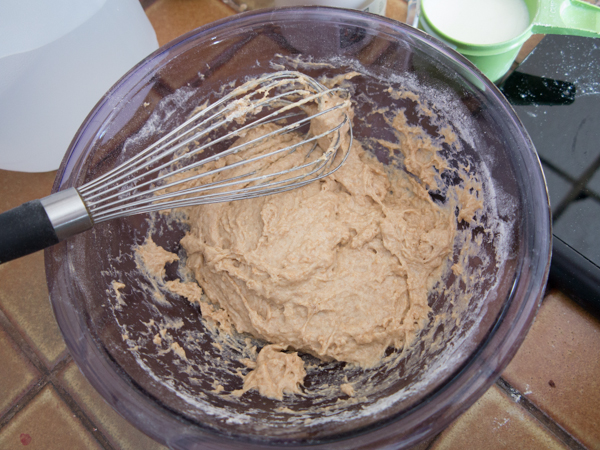
-Whisk in the remaining milk. As it gets thinner, grab a ladle, scoop some batter and pour it back in the bowl to make sure it is nice and smooth.
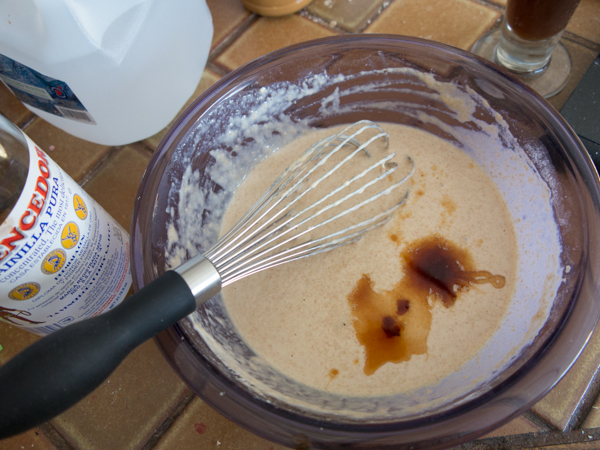
Add the milk and if needed adjust the consistency. Toss in the honey, salt and vanilla extract.
-Mix in the salt, honey and vanilla and use the ladle to check for smoothness and consistency.
-If it is too thick add some more liquid. Wise people say it should have the consistency of a pancake batter.
-Set aside in a warm (not hot!) spot for 45 min to an hour.
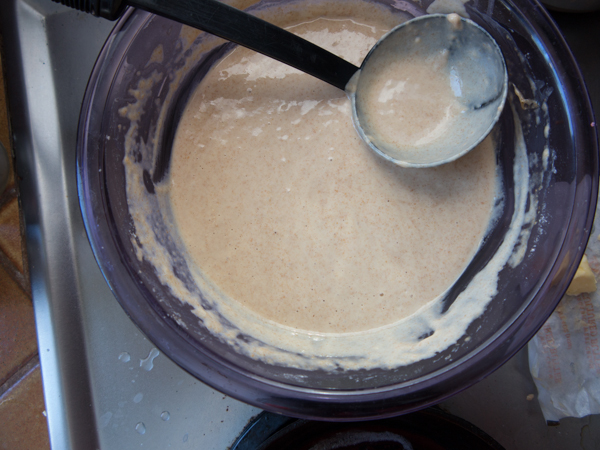
Do something else, but don’t wait for too many bubbles in the batter. This batter’s ready.
-You can go and do something else. Come back in less than an hour.
-Preheat your 6-inch cast iron pan. Butterize it.
-Scoop batter with the ladle and pour in the pan–wobble it a little, so the batter is evenly distributed.
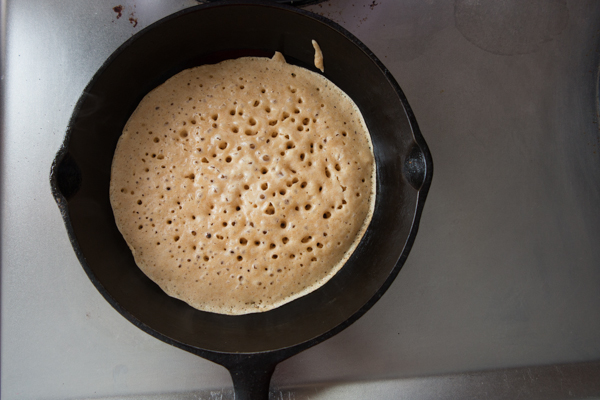
Oozing with bubbles. Just ready to flip over.
-Bake the cake at medium heat setting for around 2 1/2 min or until the surface is almost dry.
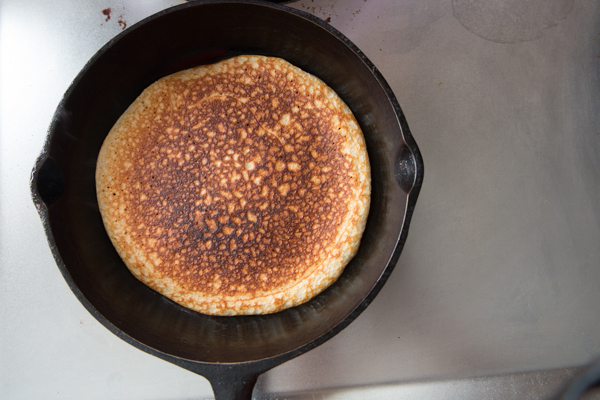
Total time of baking is 4:20.
-Flip the cake and bake for another 1 1/2 to 2 min more.
-Remove the cake from the pan, spread some butter on top and cover, so it will stay warm.
-Butterize the pan.
-Repeat until you finish the batter.
Here it is: the answer of one question from the sourdough quest–what to do with all that starter whenI can’t make any bread (my grandma didn’t teach me).

